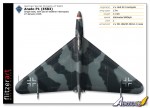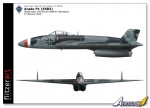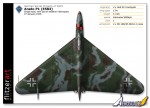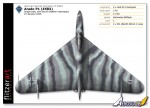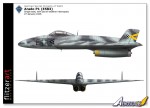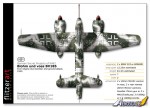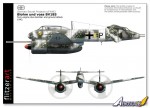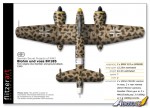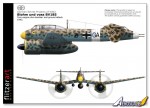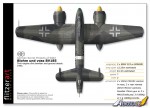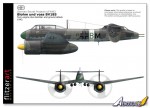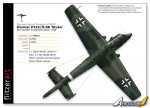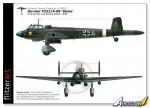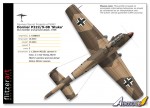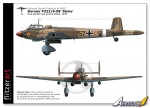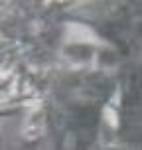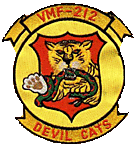1⁄1Luftwaffe Projects - Volume 9
10
Comments
Arado Ar P1 Single Seat All-Weather Fighter
Based on the aerodynamic work carried out on the Ar E.581 and E.555 Arado produced this P1 single seat fighter design in January 1945, pre-dating the better-known 2-seat nightfighter (German Secret projects of WW2 Volume 2) by 2 months. The general layout is unmistakable having a long slim cigar shaped fuselage flanked by delta wings, each with a vertical fin at the trailing edge acting as stabilisers and boundary fences.The two jet engines were mounted side by side, tucked under the extreme rear of the fuselage. The RLM criticised this. as with many early German jet engine designs, the positioning of the engines/intakes directly aft of the forward undercarriage was considered extremely risky. During take-off and landing, debris could be thrown up by the front wheel and be ingested causing serious or even terminal damage to the powerplants.
The RLM also criticised the size and thickness of the wings considering they would induce too much drag. In fact it is believed Arado replaced the near delta wings with smaller swept ones, but no drawings for this have been found. (Not the Arado Pll)
Blohm and Voss BV P185 ‘Stuka’
There is some doubt as to whether this design is a genuine Blohm and Voss creation, but the vast majority of the experts believe it to be so. But there are a small number who still have some reservations. It is probably genuine but there remains a slight doubt. However taking it to be correct, for once it seems, Richard Vogt’s team abandoned their usual asymmetric approach to produce this more ‘conventional’ 1943 Stuka project. It was intended as a replacement for the aging Ju 87, especially with the on-going Soviet assault on the Eastern front.The wing was W shaped with two BMW 323 or 2 BMW 801 engines. The engine pods housed the main landing gear and a tail wheel to the rear. The twin fins are mounted in an unusual way, hanging down from the high mounted tail-plane. Armament consisted of 2 MG 151 in the nose. with 2 remote MG 131 at the tail controlled by the second crewmember in the tail cockpit, nestled between the tail sections. A belly pod was considered for a 75mm gun or 2 MK 103. The bomb load was for three 500kg bombs or one of 1,800kg, under the fuselage.
Dorrnier P222/9-08 ‘Stuka’
Even after initial success during the Spanish Civil War, the Junkers Ju87 quickly became outdated due to rapid advances in aircraft design and developing technology. Dornier produced plans for a possible replacement in 1937. It included fixed undercarriage with spats similar to the Ju87. It also featured an air-brake tail similar to the later Arado Ar 240. It also had an unusual layout for the cockpit. It was placed alongside the engine and reminds me of an old bus.I have not had any further information regarding this project. And the Ju 87 soldiered on throughout the war.
Comments
Cheers Peter
My pleasure. It's really impressive to see how your artwork increases steadily in sophistication with each new volume.
I'm intrigued by the mysterious Wn 19 - it does just look like someone's simplistic sketch of a '109, so it'll be really interesting to see if any firm information ever surfaces...
All the best
Rowan
OCT 09, 2012 - 08:08 AM
Many thanks JPTRR, nice to see you are still around site.
Rowan, should I learn of anything more on the Wn 19, I'll definitely share any findings. I'm sure there's a lot more to be discovered.
P
OCT 11, 2012 - 06:55 AM
Great work as always Peter, It's always nice to see a different take on the colour schemes and / or just to see these projects in colour. I do like the little Skoda 257 and the Fw-222.004, and then you tease with the last line 'Italian' for Vol.10, I can't wait, Re.2007 perhaps
OCT 11, 2012 - 07:45 AM
Wonderful stuff, as usual, Pater
Do you have any profiles of aircraft that saw combat during WWII (Spit, 109 etc)?
OCT 11, 2012 - 04:17 PM
Very interesting stuff, I hope to see more in the future.
Thanks for all the effort you put into this.
OCT 15, 2012 - 07:14 AM
Many thanks, I'm just enjoying myself really.
Luciano, Re2007....we'll see .
Mal.
I did do some profiles of some British aircraft that saw actual combat. It was years ago now but they were published on site.
I've not done any more since, apart from some early jets, as there are so many accomplished artists out there that cover these already, I've tended to seek areas that are less well populated if you see what I mean.
Tah muchly
Peter
OCT 19, 2012 - 03:33 AM
"....it was the first jet combat aircraft, the first twin-jet aircraft and the first jet aircraft to go beyond mock-up stage." not so "first" considering and other constructors of jet airplanes before 1941
DEC 26, 2018 - 05:17 AM
Copyright ©2021 by Peter Allen. Images also by copyright holder unless otherwise noted. The views and opinions expressed herein are solely the views and opinions of the authors and/or contributors to this Web site and do not necessarily represent the views and/or opinions of AeroScale, KitMaker Network, or Silver Star Enterrpises. Images also by copyright holder unless otherwise noted. Opinions expressed are those of the author(s) and not necessarily those of AeroScale. All rights reserved. Originally published on: 2012-10-06 00:00:00. Unique Reads: 15547




